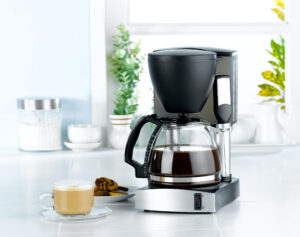How My New Coffee Maker Came with a Moment of Need Learning Approach

I recently purchased a new coffee maker. I’d be embarrassed to describe my old one, so I’ll not go there. The new one isn’t high-end, but it does have a lot of features that work well for my husband’s and my varied preferences: it brews different strength coffees and various size cups and pots, and even heats water for tea and froths my milk! When it arrived, I eagerly read the directions to set it up. I couldn’t help but look for the good, and not-so-good, instruction in the accompanying documentation. I identified two examples of both instruction types, items I find helpful to keep in mind in my work life doing instructional design.
Something I was excited about: There were two sets of instructions, one of which was the “quick start” guide, which would enable me to use my coffee maker almost immediately, a great benefit for this under-caffeinated learner. Fantastic. Just what I needed. I read that right away. It told me how to prepare the coffee maker for first use. I did what it said to do and was quickly ready to brew my first cup.
But I decided to read the fuller instructions, you know, just in case I needed to avoid making costly mistakes before adding my ground beans and water. Wouldn’t you know it? The instructions for first use were slightly different. For one, it omitted the part about cleaning all the parts first. Okay, so perhaps that’s obvious to some, but it could have been succinctly included in the quick start guide.
A frustration I had with the fuller instructions was the repetition of some of the steps based on the coffee strength and cup size. I had to reread a few times to discern the differences. It would have been so much easier to absorb if it were set up in a table format, with the differences highlighted and avoiding repetition. I know, it’s just coffee. I could toss a cup of palm-hair-growing strength if I messed up.
But things don’t always go smoothly, at work or making coffee. My work often deals with more serious impacts if the learner cannot quickly and easily understand the instructions for what to do on the job, so this bothered me. And hey, no one wants weak coffee on a Monday morning.
Another thing I was excited about: After reading the complete instructions (and washing the pertinent parts) I needed to locate the right place for the grounds, the correct settings for my preferred style of coffee, and the frothing situation. Each of the functions on the coffee maker had small stick-on notes about what to do. “Close this lid to brew grounds,” “Flip this switch for hot water,” “Twist to remove (frother).” I suppose these prompts were based on common questions users might have (based on this user).
That last point is a second great example of providing learning in the moment of need (see How to Use The 5 “Moments of Need” Model In Corporate eLearning – eLearning Industry)! I can leave those stickers on until I remember all the details without prompts. Then I can remove them. Or leave them on for house guests who wish to brew their own. This is one area of instructional design we sometimes neglect, instead expecting our learners to read the complete instructions and hoping they’ll remember what to do. By including “Moments of Need” tactics such as quick reference guides and on-the-job prompts, including tips for the unexpected, we can ensure that learners perform their work more immediately and more accurately.
My coffee making has gone to new heights. Cappuccino, anyone?


